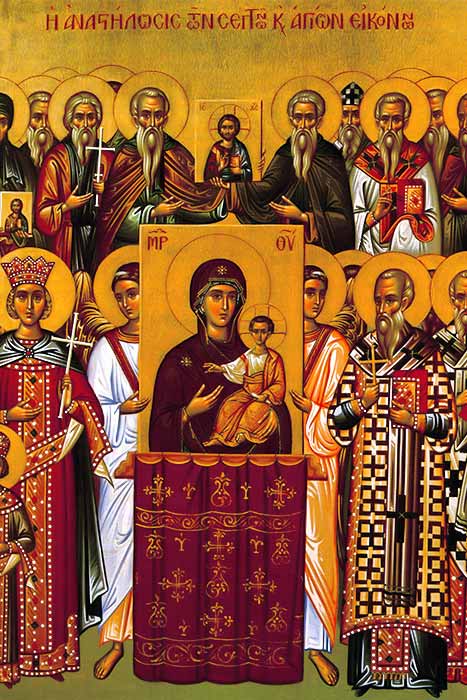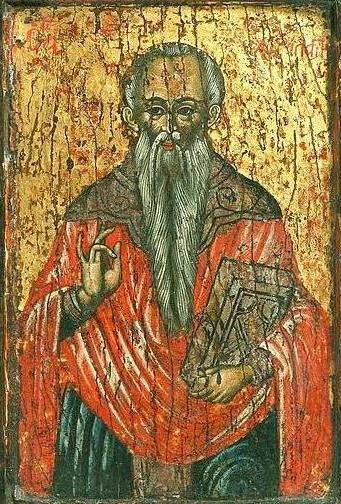For it is written that Abraham had two sons, one by a slave and one by a free woman. But the son of the slave was born according to the flesh, the son of the free woman through promise. Now this is an allegory: these women are two covenants. One is form Mount Sinai, bearing children for slavery; she is Hagar. Now Hagar is Mount Sinai in Arabia; she corresponds to the present Jerusalem, for she is in slavery with her children. But the Jerusalem above is free, and she is our mother. For it is written, “Rejoice O barren one who does not bear; break forth and shout, you who are not in travail; for the children of the desolate one are many more than the children of her that is married.”
Galatians 4: 22-27 (Epistle from Feast of Conception of the Virgin Mary by St. Anna)
On December 9, we celebrate the Feast of the Conception of the Virgin Mary, by St. Joakim and St. Anna. We know that Joakim and Anna were advanced in years and did not have any children. We know also that at that time (NOT in contemporary times) that those who did not have children carried a stigma, perhaps were even viewed as being forsaken by God. (Again, as our understanding of marriage evolved, specifically in the New Testament book of Ephesians, we know that the goal of a marriage is not to have children, but for two people to share in the journey to salvation. Children are a blessing, which not all couples choose to have or are able to have). We also know that Joakim and Anna were very faithful people. They had a strong faith in God despite their life’s circumstances or what people may have thought about them. In their old age, they were conceived a child, and this child was going to be the woman who would bear in her womb the Son of God. They conceived the Virgin Mary and after she was born, they gave her at about age two or three to be raised by priests in the temple, so that she would be pure until the day chosen for the Incarnation.
If we were to divide the history of the world into chapters, the first chapter would be the Creation, when the world was perfect. The second chapter would be the Fall of mankind. The third chapter would be the redemption of mankind through Jesus Christ. The conception of the Virgin Mary is the end of that second chapter and the beginning of the third. The conception of St. John the Baptist (celebrated on September 23, which also has the same Epistle reading) is the first event recorded in the New Testament. The conception of the Virgin Mary is not mentioned in the Gospels but is found in other writings of early Christianity and was initially passed down through oral history.
The Epistle lesson, taken from St. Paul’s Letter to the Galatians, refers to the Old Testament. In the book of Genesis, we read that Abraham and his wife Sarah, were not able to conceive children. In Genesis 16, we read that Sarah (at the time called Sarai) told Abraham (at that time called Abram) that he should be with her maid, Hagar, since she could not give him children. So, Abram went with Hagar and she conceived an illegitimate son, whom she named Ishmael. It was told by an angel that Ishmael “shall be a wild ass of a man, his hand against every man and every man’s hand against him. (Genesis 16:12)
Later, after God made a covenant with Abraham, He promised that Sarah would conceive in her old age. So, now Abraham ended up with two sons, one illegitimate and one the product of his union with Sarah.
Saint Paul refers to these two sons, comparing the two women to two allegories. Hagar represents the Old Covenant, given on Mount Sinai in the Ten Commandments. This covenant gave order, just like the conception by Hagar gave Abram a son. But neither was an ending. Ishmael did not play out to a good ending and neither did the Old Covenant.
A New Covenant came through the Incarnation of Jesus Christ. The New Covenant is perfect and permanent. It has replaced the Old Covenant. Our hope is not found in keeping good order but in the sacrificial love that Christ showed to us. We are descended from Abraham, but not from the line of Ishmael but through the line of Isaac, Jacob, then to David and ultimately to Jesus.
Before the Incarnation of Christ was the birth of His mother, the Virgin Mary. And before her, there were two pious and faithful parents, Joakim and Anna, who like Abraham and Sarah, and later Zaharias and Elizabeth (parents of John the Baptist) gave birth miraculously in old age to people who were the most significant precursors to the coming of God’s Messiah. John the Baptist. Before John was born, while Elizabeth was pregnant, this is when the Annunciation took place. So, if we were to mark the first event or our salvation, it would be the conception of the Virgin Mary (the first scriptural event would be the conception of John the Baptist). Her Nativity is celebrated on September 8, nine months later.
Today the bonds of childlessness are broken. For hearing the prayers of Joachim and Anne, God promised that against all hope they would give birth to the Mother of God. He, the Uncircumscribed, would be born of her, when He would become man, and by the Angel’s example, He commands us to call to her: “Rejoice, Maiden full of the grace, the Lord is with you.” (Apolytikion, Feast of the Conception of the Virgin Mary, Trans. by Fr. Seraphim Dedes).
Knowing our history helps us know where we come from and how we came to be where we are. We are reminded today that we are descendants of Abraham through Isaac and not Ishmael, and that we are followers now of the New Covenant and not the Old Covenant. The change begins first with the Conception of the Theotokos, which we commemorate on December 9.

